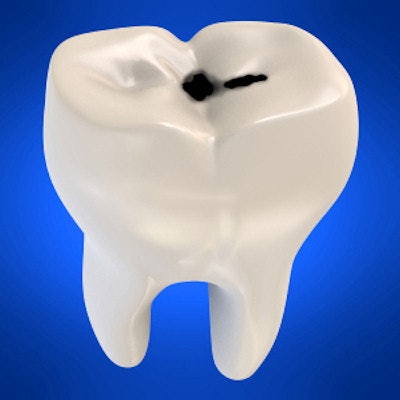
Researchers have developed a pH-sensing device that uses dye and LED excitation to predict caries risk. Results of a pilot study conducted with a prototype suggest that although this device avoids the problems of previous dye-based pH measurement techniques, it requires some modifications before it will show up in your office.
The device measures the time-dependent drop in pH in patients, and it shows promise but is not quite ready for use on your patients, the researchers reported in the Journal of Biomedical Optics (January 8, 2019).
"The research shows that we can measure oral biofilm pH easily, quickly, and quantitatively, even on the occlusal surface, which pH strips have failed," study co-author Eric Seibel, PhD, told DrBicuspid.com. Seibel is a research professor of mechanical engineering and director of the Human Photonics Lab at the University of Washington in Seattle.
How low can you go?
A clinical measure of plaque activity is needed to alert the dentist about a patient's vulnerability to dental decay. One way to measure this is by evaluating the acid production capability of plaque deposits in the pits and fissures of occlusal and interproximal regions.
“The research shows that we can measure oral biofilm pH easily, quickly, and quantitatively.”
Two methods currently used are electrical probe devices and confocal laser scanning microscopy. As both methods have limitations, researchers developed a new technique for measuring biofilm pH using a U.S. Food and Drug Administration-approved fluorescent dye, fluorescein, and a fiber-optic probe that can measure acidity levels in dental spaces, including occlusal pits and fissures.
The researchers sought to diagnose caries and also predict their occurrence. This required the expertise of investigators with various backgrounds, including lead study author Manuja Sharma, a doctoral student in electrical and computer engineering at the University of Washington.
The team constructed and calibrated a fiber-optic pH probe, which can measure pH from 4.5 to 7 and uses a 420-nm LED as an excitation source. The group then conducted an in vitro study on two surgically extracted impacted third molars, followed by a pilot study in eight individuals. Two participants voluntarily refrained from brushing their teeth on the day of the study.
For testing, a dentist chose one tooth surface in each of the four quadrants that looked as though it had a high plaque load but no interproximal spots. After resting pH was measured with ambient light, autofluorescence, and fluorescein, the participants then rinsed their mouths to remove the fluorescein and then rinsed again.
The researchers measured pH values after one minute and three more times every five minutes after that. The buccal surface of tooth number eight was used as a control assumed to have a low plaque load.
Afterward, participants underwent tooth cleaning and evaluation using Caries Management by Risk Assessment (CAMBRA), which found one of them to be high-risk, one medium, and six low-risk.
The average resting pH on the control tooth was 6.91, and the average pH drop was 0.4 after use of the sucrose rinse. The researchers made experimental measurements using occlusal surfaces, revealing a pH drop of 0.4 or more in six of the individuals for at least one quadrant within five minutes of using the rinse, with a recovery trend toward resting pH.
"We were pleased by the results from in vitro studies as they were clean and reproducible for an initial prototype, but the clinical work is much more variable," Seibel said.
Dentists might be able to use this device to measure resting pH and its relative drop with the sugar challenge for all enamel areas in their patients and track individual or clinic data over time, he explained.
Modifications needed
Although the pilot study demonstrated low variability in resting pH measurement, limitations included having only one high-risk subject and none with active caries, making it difficult to establish correlations between pH and caries detection. The researchers now are designing a study to measure oral biofilm pH in children known to be at high risk for caries.
They also are improving the device, including making it more effective with ambient lighting and formulating the pH-sensitive dye to remain on plaque for longer.
"We envision this device being used to rank the relative risk of plaque deposits within the mouth when the subject comes into the dental clinic prior to teeth cleaning," Seibel told DrBicuspid.com. "This method can also be used outside the clinic with more simplification and cost reduction, so the user can quantify their plaque load and caries risk over time."



















